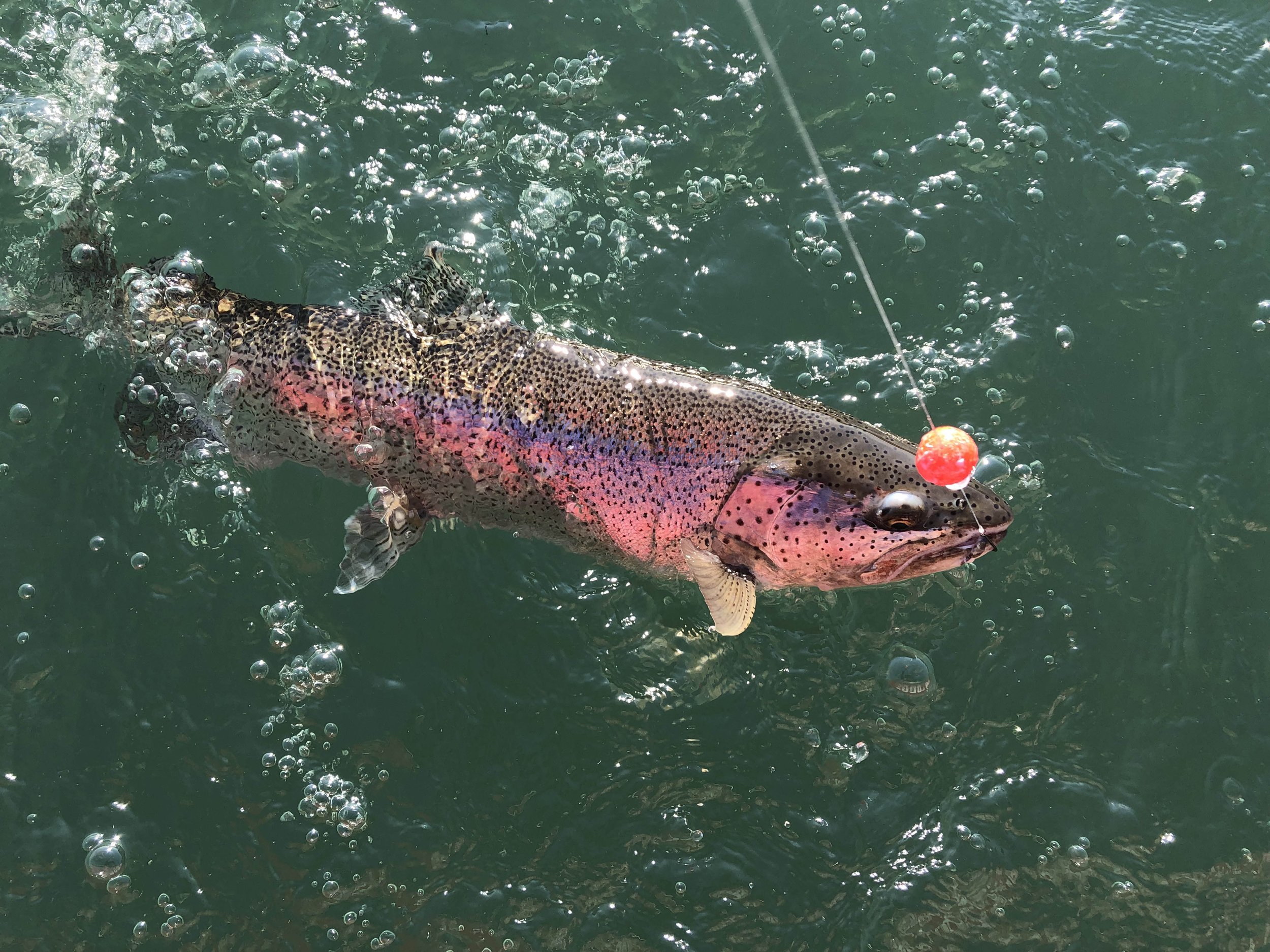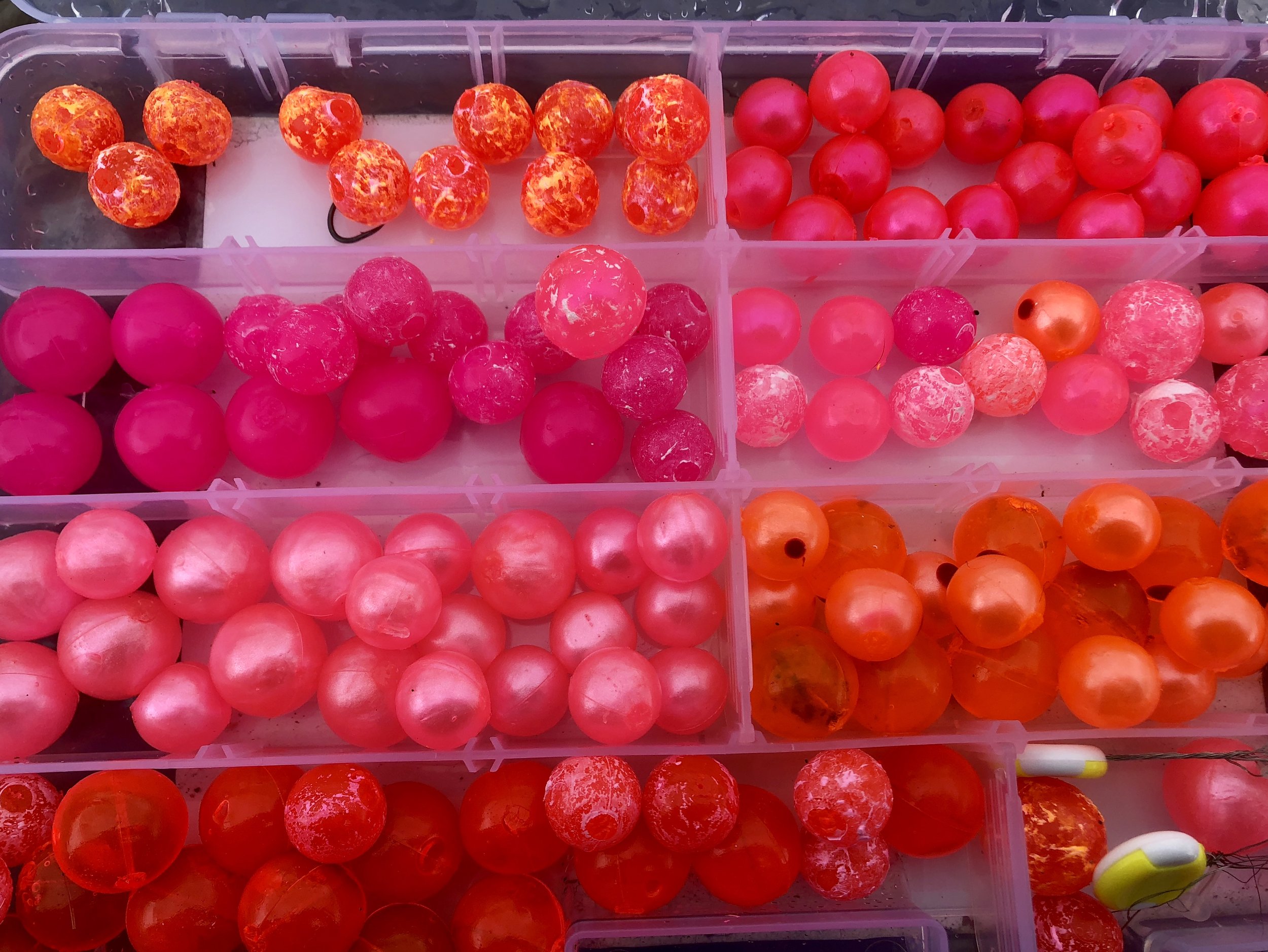Bobber-Doggin’ for Steelhead
JD with a nice wild summer-run caught on bobber-doggin’ gear.
Bobber-doggin’ is one of the hottest and most effective ways to catch steelhead these days. It’s a slick hybrid technique that pairs the best attributes of two of the most popular river fishing styles: drift fishing and float fishing.
Traditional drift fishing for steelhead involves bouncing your offering along the bottom with the help of a piece of pencil lead or a slinky. It’s a great searching tool and, because you are constantly dragging the bottom, you know your bait is always down where the fish are. However, you tend to get snagged quite a bit fishing this way. Also, it can be difficult for beginners to distinguish the tap-tap-tap of the bottom from the usually fairly subtle bites of a steelhead.
This is just a small part of what you can learn in my online course. Click here for more info.
Now, you can keep your gear up off the bottom a bit by suspending it under a float. You'll obviously get snagged much less frequently – and it’s a great way to cover ground and find fish. Unless you have a uniform bottom, however, your gear can end up way out of the strike zone unless you are constantly adjusting your bobber stop’s depth setting.
While not difficult, bobber fishing also requires you to mend your line frequently to keep everything drifting at the proper speed.
These little hassles associated with drifting and float fishing are not insurmountable, but bobber-doggin’ gives you the best of both worlds – with almost no downside.
A Closer Look
In its simplest form, bobber-doggin’ is drift fishing with a bobber. A piece of pencil lead or a slinky (some folks also use Dave’s Tangle-Free Weights) is used to get the bait to the bottom – and the sinker taps the whole time – but you also have a slip bobber up the line.
The bobber is set deeper than it would be on a traditional suspended rig (more on that later) and serves two purposes: First, you have a built-in strike indicator which helps convert bites into hookups. The visual of a bobber going under really helps anglers who struggle with getting the feel of a bite.
Secondly, the bobber getting pulled downriver helps the sinker skim, rather than pound, the tops of the rocks, making it less prone to getting hung up.
Also, a standard bait drifting rig will tend to swing in an arc towards you as it drifts, while a bobber-dogged bait can be fished in a straight line for long distances. That's a real plus when you are trying to work a distant seam or slot.
Rigging Up
Okay, so now you have the basic gist of bobber-doggin.' Now, let's take a look at how to rig up. There are several ways to go from semi complicated to pretty simple. I have tried many and keep coming back to a very basic style that seems to work wherever I go.
My favorite rod for bobber-doggin’ is the Douglas Outdoors LRSS9842F, which is a 9-foot, 8-inch spinning. I then pair it with a 3500 size spinning reel spooled with 30-braid – preferably something in a bright yellow, green or white hue. The color makes the line much easier to see and manage when you are fishing. In clear streams, I'll take a black Sharpie pen and darken the last 20 feet of my line so I don't spook the fish. In off-colored water, you can run the bright stuff direct to the swivel.
Once the reel is spooled and the rod is strung up, side a bobber stop up the main braid. I like the kind that comes in knot form on a small plastic tube. Simply slide the line through the tube, slip the stopper knot onto the main line and then discard the tube.
Next, slide a small plastic bead up the line and then add the slip float. I like the medium sized Hawken’s Bobber-Doggin’ or Bobber-Doggin Chubby style floats. They have a flat bottom, which helps catch the current and push the rig along. You can also achieve the same thing with cheap foam floats by simply cutting the bottoms flat with a pair of scissors.
The next item to slide up the main line is a snap swivel. To the snap goes your sinker. Again, pencil lead or slinkies are the best choices. You want enough lead to get your bait to the bottom – but not so much that it's heavily pounding it. A nice, light tap is perfect.
Next, add another small bead and then finish off by tying a crane swivel to the end of the line.
To the other eye of that swivel goes the leader. When drifting eggs, I'll run about 4 feet of monofilament down to the hook (8- to 12-pound) and then use a No. 2-4 Owner octopus style hook attached via an egg loop.
Bait can be run “naked” or you can add a floatation device on the leader ahead of it. Chartreuse, orange or rocket red Spin-Glo’s, Cheaters and Corkies are all good choices for adding color and buoyancy to the bait.
How to do it
Set the bobber stop to approximately one and half times the water's depth. This is simply a place to begin and you may need to adjust your depth throughout the day. Again, since we aren't suspending the bait under the bobber, we need to run our stops deeper than the river depth so that the rig has enough “scope” to drag bottom.
Now, cast upstream and across. Depending on the current's speed, somewhere between slightly upstream to 45 degrees upriver will be right.
If the depth is set correctly and your drift is correct, the bobbers will lay flat in the water, with their brightly pointed tops upstream.
What’s happening here is the sinker is dragging the bottom and that causes the float to slow down and ride nose-upriver. To keep the rig dragging at the proper speed downstream, I like to leave a few feet of line in the water in a slight bow below the bobber. With a little bit of current pushing on the line, the bobber almost acts like a little boat, towing the gear down the run — and out of the snags.
This is quite different from traditional bobber fishing, where you want to keep as much line off the water as possible and the float riding mostly straight up and down. It definitely takes a little getting used to…
Eventfully, you'll get the rhythm of it and then the benefits will become increasingly more clear. Snags get fewer and farther between, bait doesn't fall off so fast and you spend a lot more time fishing instead of adjusting bobber depths and changing baits.
And then things get really fun when the bobber goes down...
The Bite
By design, you are going to have a small length of loose line in the water downstream of your bobber. That means a standard hook set isn't going to cut it. Jerk the rod when you see the bobber go down and all you are doing is straightening out the line – not setting the hook solidly.
So instead, remember this little mantra: Reel until you feel. When the bobber dips, crank up the loose line as fast as you can. When it comes tight and you feel some resistance, set the hook. It's hard to remember to do this in the heat of battle, but you'll stick the hook into a lot more steelies if you do!
Other offerings
While fresh eggs are always a great bobber-doggin’ bait, I really enjoy fishing pegged 16-25mm soft beads, pegged a couple inches above the hook. Yarnies are also a good choice, as are plastic worms, nightcrawlers and shrimp.







